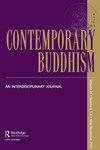THE CITY OF NIBBĀNA IN THAI PICTURE BOOKS OF THE THREE WORLDS
IF 0.1
3区 哲学
0 PHILOSOPHY
引用次数: 0
Abstract
ABSTRACT Throughout its long history, Buddhist meditation has been a lasting source of happiness, and its ultimate goal has been the imperturbable stillness of mind after the fires of desire, aversion and delusion have been finally extinguished. This state is called in Pali nibbāna, the place of perfect peace and happiness. In his classical book on Thai painting, Jean Boisselier confidently states: ‘Artists are of course unable to depict any aspect of nibbāna, since that world is by nature without form’. This article will show that more than two centuries ago Thai artists did just that which Boisselier proclaimed to be impossible. Thai artists drawing the cosmos in Picture Books of the Three Worlds (สมุดภาพไตรภูมิุ [Samutphāptraiphūm]) did indeed depict nibbāna. Some drew an ‘empty space’, but among the older manuscripts most drew a complex ‘City of Nibbāna’. It will be determined what this elaborate City of Nibbāna stands for. Finally, the question is raised whether or not the City of Nibbāna is part of a type of Buddhism that was suppressed in early modern times.城市nibbĀna在泰国绘本的三个世界
在佛教漫长的历史中,禅修一直是快乐的持久源泉,它的最终目标是在欲望、厌恶和妄想的火焰最终熄灭后,达到内心的平静。这个州在巴利语中被称为nibbāna,是完美和平与幸福的地方。Jean Boisselier在他关于泰国绘画的经典著作中自信地说:“艺术家当然无法描绘nibbāna的任何方面,因为那个世界本质上是没有形式的。”这篇文章将表明,两个多世纪前,泰国艺术家做到了布瓦塞利耶宣称不可能做到的事情。泰国艺术家在《三个世界图画书》([Samutphāptraiphūm])中描绘的宇宙确实是nibbāna。一些人画了一个“空白的空间”,但在更古老的手稿中,大多数人画了一个复杂的“Nibbāna之城”。这个精心设计的Nibbāna之城代表着什么,将会被决定。最后,提出了一个问题,即Nibbāna城是否是在近代早期被压制的一种佛教的一部分。
本文章由计算机程序翻译,如有差异,请以英文原文为准。
求助全文
约1分钟内获得全文
求助全文

 求助内容:
求助内容: 应助结果提醒方式:
应助结果提醒方式:


